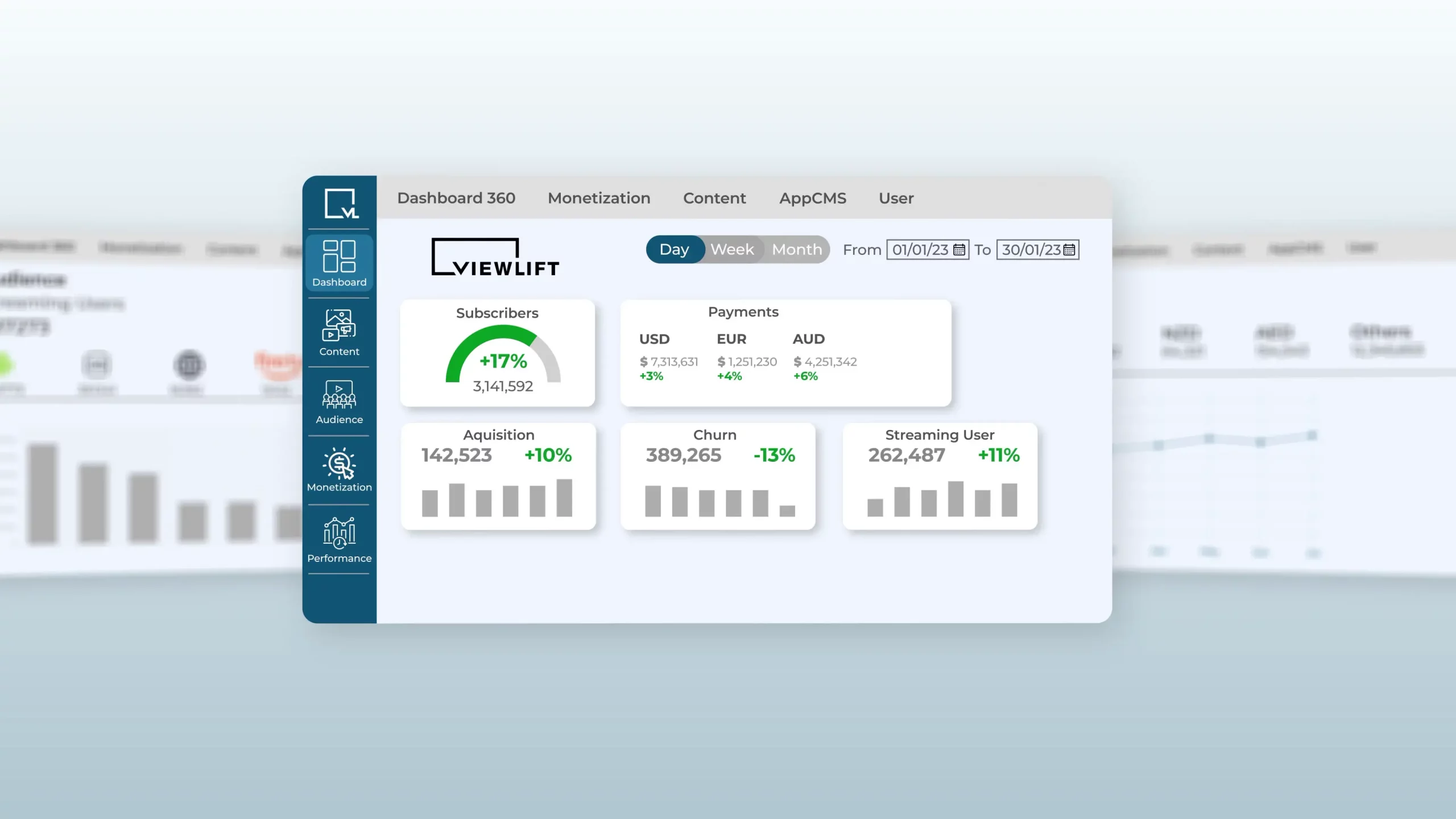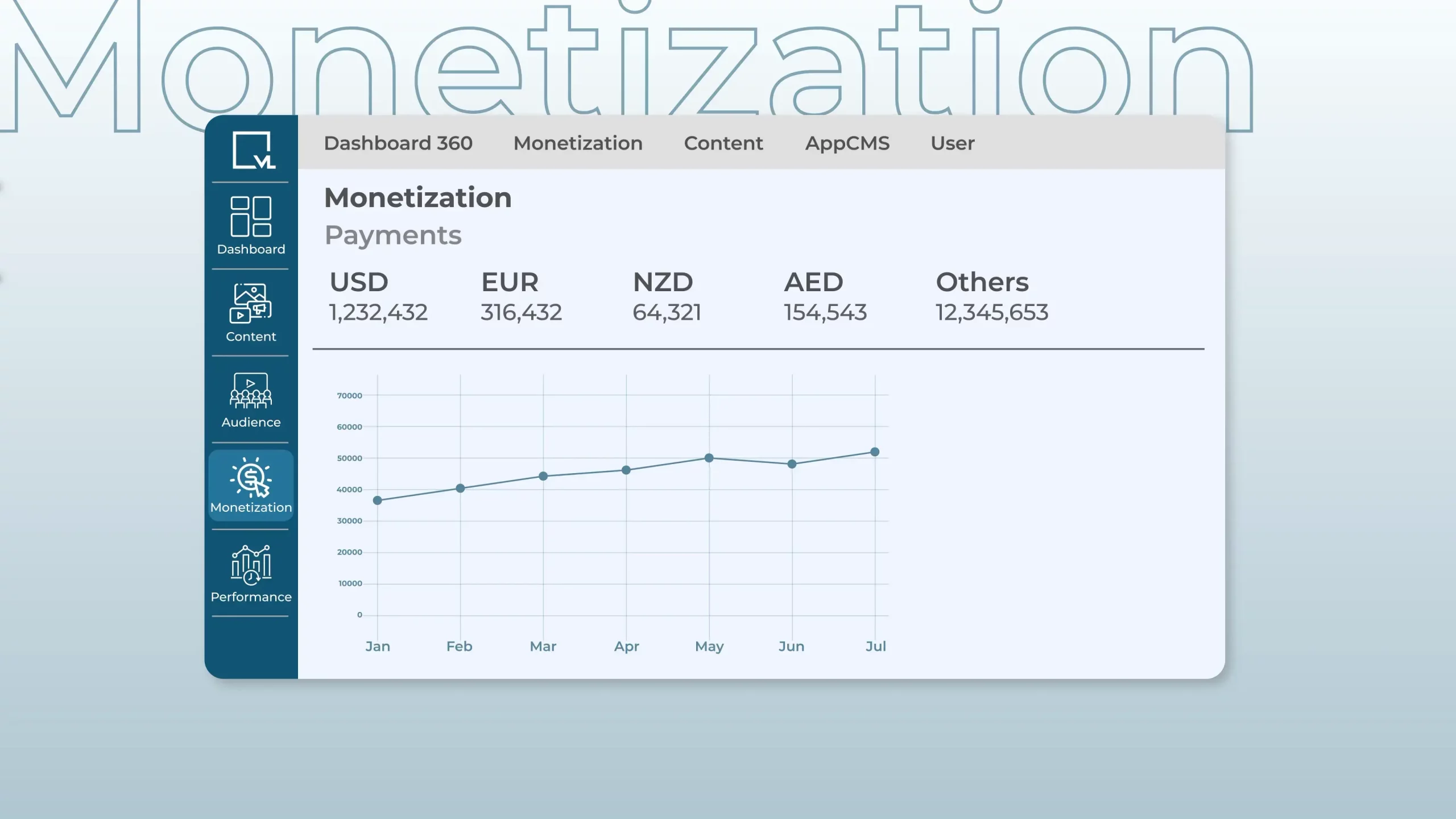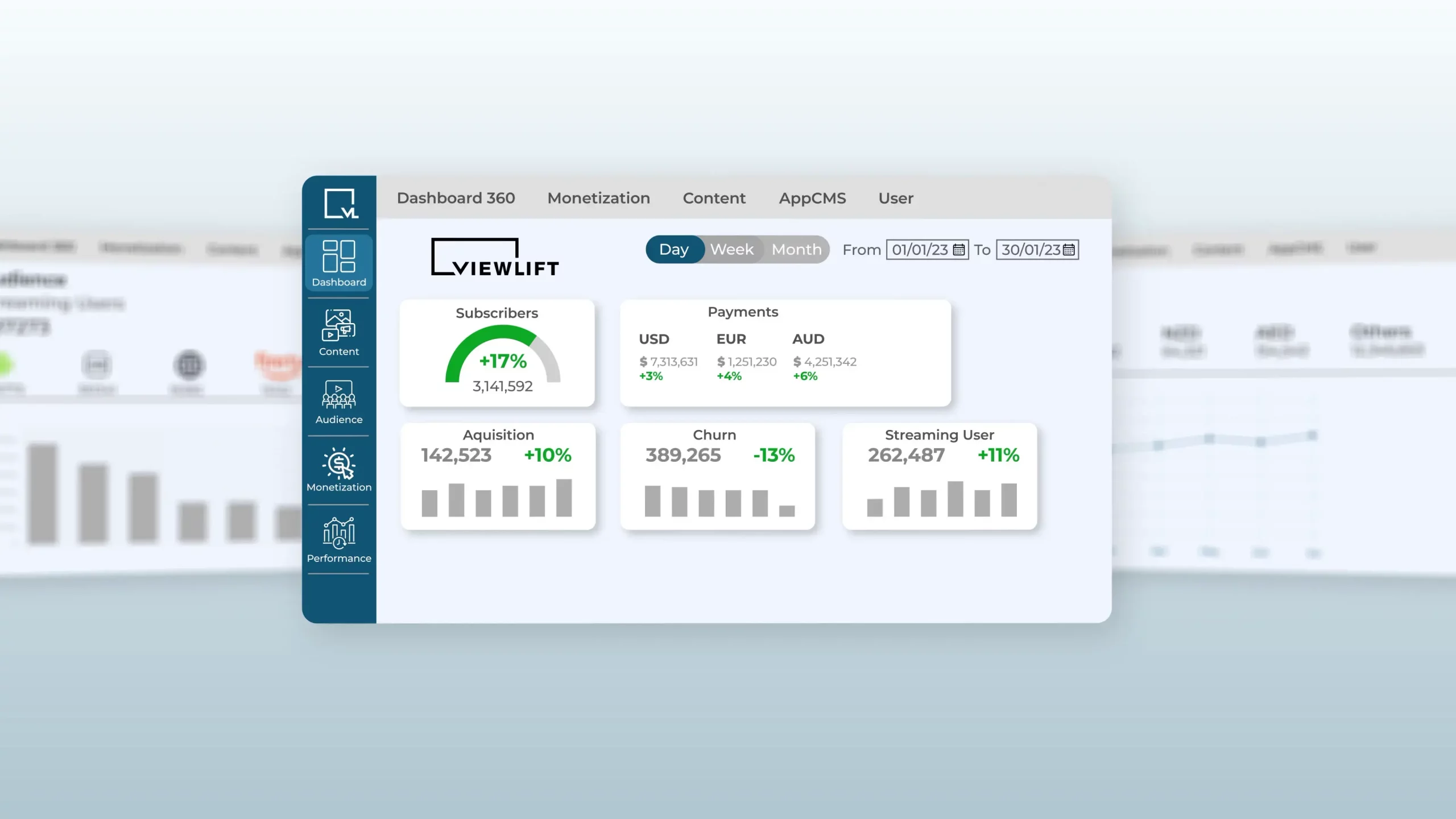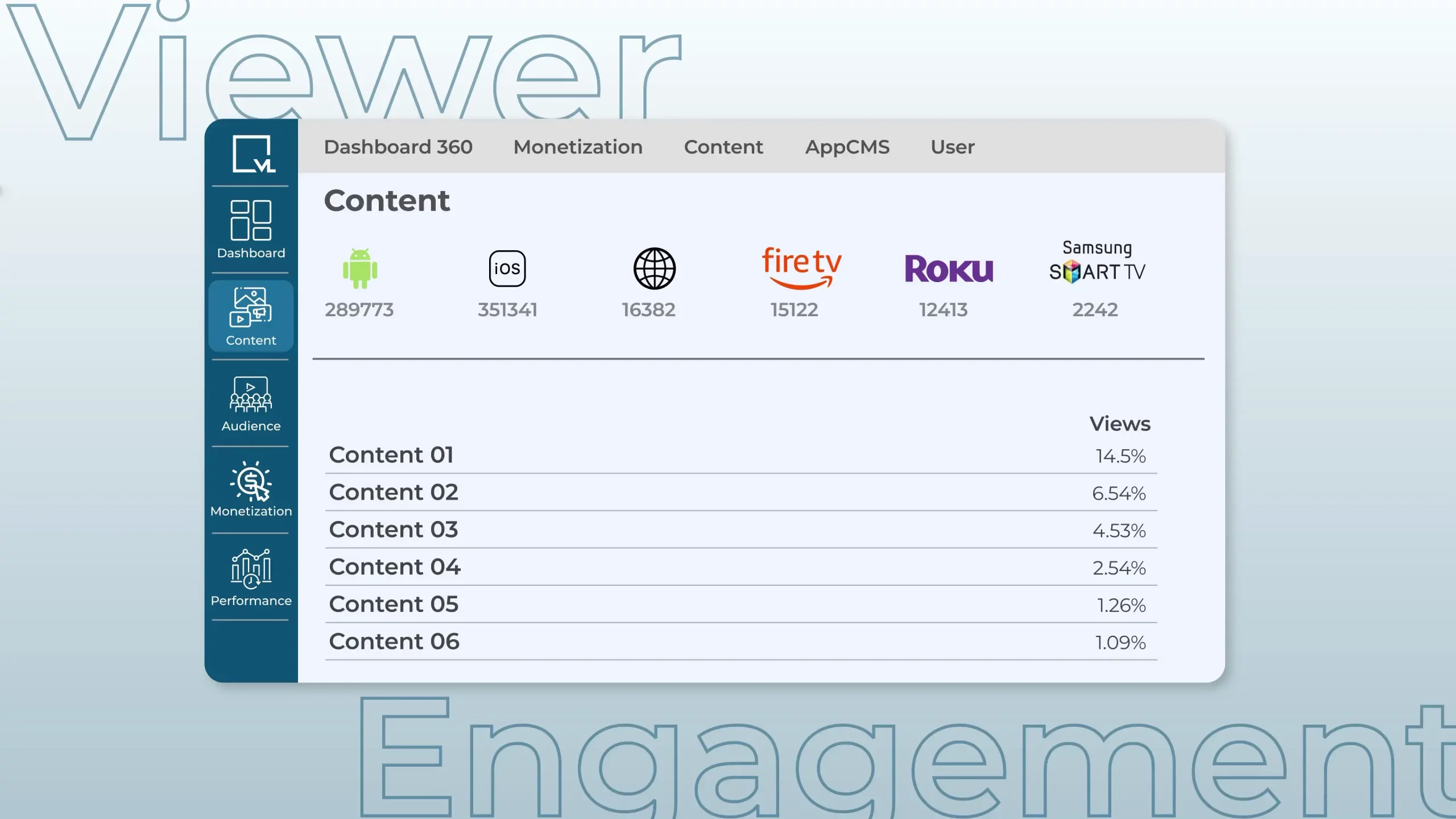Live Sport Streaming: 10 Tips to Online Broadcasting Success
June 23, 2023 • Sports OTT, live streaming platform, boadasting

ViewLift Team
Marketing
Welcome to the captivating world of live sport streaming and online broadcasting, where fans can now indulge in their favorite matches anytime, anywhere, and on any device. The Sports Online Live Video Streaming Market, valued at USD 18,689.05 million in 2021, is projected to reach an impressive USD 93,016.95 million by 2030, with a remarkable compound annual growth rate (CAGR) of 24.64% from 2022 to 2030.
As the demand for live sports streaming continues to soar, content providers find themselves facing an exhilarating yet fiercely competitive market. In this dynamic landscape, standing out from the crowd requires more than just securing broadcasting rights. It demands an unwavering commitment to delivering an exceptional user experience, impeccable stream quality, and a diverse array of sports content.
Whether you’re an established OTT provider seeking to elevate your game or a passionate newcomer looking to make your mark, this comprehensive guide is your key to unlocking online broadcasting success. With the ever-expanding market and the immense growth potential ahead, now is the perfect time to seize the opportunity and establish your presence in the world of live sports streaming. We have distilled the wisdom of industry leaders and experts into ten essential tips that will propel your live sports streaming venture to new heights.
Table of Contents:
I. Live sports streaming: The future of sport
II. How to be successful in online broadcasting
III. Overview of 10 essential tips
Tip 1: Choose the right streaming platform
Tip 2: Implementing robust OTT broadcasting solution
Tip 3: Securing rights and licensing
Tip 4: Build or utilize an existing CDN for seamless streaming
Tip 5: Create an engaging user experience and interface design
Tip 6: Monetization strategies for live sport streaming
Tip 7: Data analytics and audience insights
Tip 8: Increasing viewer engagement and interaction
Tip 9: Ensure high-quality streaming and reliability
Tip 10: Ensure security and privacy
IV. Conclusion
Live Sports Streaming: The future of sport
In the age of digital transformation, live sports streaming has emerged as the undeniable future of sport consumption. The rapid advancement of technology, coupled with the insatiable appetite of sports fans for convenient and personalized viewing experiences, has propelled this revolution forward. Gone are the days of being tied to a television set or limited by geographical boundaries. Today, fans have the power to access and engage with their favorite sports in ways unimaginable just a decade ago.
Breaking down barriers: Global reach and accessibility
One of the most significant advantages of live sports streaming is its ability to transcend geographical limitations. No longer confined to a single region, sports enthusiasts from around the world can now enjoy live coverage of their beloved teams and athletes. Whether you’re in Tokyo or Toronto, London or Los Angeles, the thrill of the game is just a few clicks away. This global reach not only connects fans worldwide but also opens up new markets and revenue streams for sports organizations and broadcasters.
Moreover, live sports streaming has shattered the barriers of traditional broadcasting schedules. Fans no longer have to rearrange their lives around fixed match times or miss out on crucial moments due to other commitments. With the power to stream matches on-demand, pause, rewind, or even watch multiple games simultaneously, sports enthusiasts can curate their own viewing experiences according to their preferences and availability.
Personalization and immersive experiences
Live sports streaming platforms have embraced the concept of personalization to enhance the fan experience. By leveraging data analytics, artificial intelligence, and machine learning, these platforms can deliver customized content recommendations based on individual preferences, viewing history, and interests. Whether it’s highlighting key moments, providing in-depth player statistics, or offering tailored commentary, every fan can enjoy a personalized journey through the world of sports.
Furthermore, the integration of interactive features has brought about a new level of engagement. Fans can participate in live polls, chat with fellow enthusiasts, or even access real-time player data during matches. Augmented reality (AR) and virtual reality (VR) technologies are also pushing the boundaries of immersion, allowing viewers to step into the shoes of their favorite athletes and experience the adrenaline rush firsthand.
Beyond the screen: Social connection and community building
Live sports streaming has fostered a sense of community and social connection among fans. Online platforms provide spaces for like-minded individuals to interact, share their thoughts, and celebrate victories together. Whether it’s through live chats, dedicated forums, or social media integration, fans can engage in real-time conversations, debates, and celebrations, transcending the boundaries of physical proximity.
Sports organizations and broadcasters have recognized the power of this communal experience and are actively incorporating it into their streaming services. By providing exclusive behind-the-scenes content, player interviews, and post-match analysis, they deepen the connection between fans and the sports they love, cultivating a loyal and passionate community.

How to be successful in online broadcasting?
As the demand for live sports streaming continues to grow, content providers must strive to succeed in the competitive online broadcasting market. With broadcasting rights for sports becoming increasingly sought-after, it is crucial for content providers to differentiate themselves by delivering a great user experience, providing high-quality streams, and offering a diverse range of sports content. To help you navigate the dynamic landscape of live sports streaming, we have compiled a list of 10 essential tips for success.
Overview of 10 essential tips
If you’re ready to embark on a thrilling journey filled with insights, strategies, and innovative approaches, join us as we delve into the secrets behind achieving online broadcasting excellence. From selecting the perfect streaming platform to securing broadcasting rights, implementing robust broadcasting solution, and creating an immersive user experience, we leave no stone unturned.
Prepare to witness the transformational power of live sports streaming and learn how to captivate audiences, engage fans, and leave an indelible mark on the ever-evolving world of sports media. Let’s dive in and unveil the key to unlocking your online broadcasting success!
Tip 1: Choose the right streaming platform
A. Understanding streaming platform features
When selecting a live streaming platform, it’s crucial to understand the key features and functionalities they offer. Look for platforms that provide robust video hosting capabilities, customizable player options, monetization tools, analytics, and cross-platform compatibility. These features will enable you to deliver a seamless streaming experience to your audience.
B. Considerations for Platform Selection
- Platform Scalability and Reliability: The scalability and reliability of a streaming platform are paramount for handling high traffic volumes and ensuring a smooth streaming experience. One platform that excels in this aspect is ViewLift. With its robust infrastructure and proven track record, ViewLift has been trusted by numerous content providers to handle large audiences and deliver high-quality streams consistently.
- Pricing Structure and Value: Consider the pricing structure of the streaming platform and evaluate if it aligns with your budget and long-term goals. ViewLift offers flexible pricing options tailored to the needs of content providers, ensuring that you can find a suitable plan that offers excellent value for your investment.
- Customer Support: Having reliable customer support can make a significant difference in managing your streaming service effectively. ViewLift prides itself on its dedicated customer support team, ready to assist you at every step of your streaming journey.
- Integration Options: Consider the integration options offered by the streaming platform. ViewLift offers seamless integration with various third-party tools and services, allowing you to optimize your streaming service by leveraging complementary technologies. Whether it’s ad networks, analytics platforms, or content management systems, ViewLift offers the flexibility to integrate with the tools that best suit your needs.
Tip 2: Implementing robust OTT broadcasting solution
Implementing robust over-the-top (OTT) broadcasting solution is crucial to delivering a seamless viewing experience to your audience. With a multitude of options available, it’s essential to choose a reliable and feature-rich solution that meets your streaming needs. ViewLift, a leading provider of OTT solutions, stands out as an exceptional choice for content providers looking to elevate their streaming capabilities.
A. The Power of ViewLift’s OTT Broadcasting Solution:
ViewLift offers a comprehensive and cutting-edge OTT broadcasting solution that empowers content providers to deliver high-quality live sports streaming. Here’s why ViewLift stands out as the best choice:
- Advanced Video Delivery: ViewLift’s OTT solution leverages state-of-the-art video encoding and streaming technologies to ensure smooth and reliable delivery of sports content to a global audience. With adaptive bitrate streaming and intelligent content delivery networks (CDNs), ViewLift optimizes video playback across devices and network conditions, providing an uninterrupted viewing experience.
- Customizable Player Experience: ViewLift’s platform provides a highly customizable player experience, allowing content providers to design branded player interfaces that align with their brand identity. From personalized colors and logos to interactive features like live stats, social media integration, and multi-camera angles, ViewLift empowers content providers to create engaging and immersive viewing experiences for sports enthusiasts.
- Monetization Opportunities: ViewLift understands the importance of monetizing live sports streaming effectively. Their platform offers versatile monetization options, including subscription models, pay-per-view events, in-stream ads, sponsorships, and more. By leveraging ViewLift’s monetization tools, content providers can generate revenue while offering value to their viewers.
- Analytics and Insights: ViewLift’s analytics capabilities provide valuable insights into audience behavior, engagement metrics, and content performance. With comprehensive data and reporting, content providers can make data-driven decisions to optimize their streaming strategy, enhance user engagement, and identify monetization opportunities.
B. Success Stories: ViewLift’s Impact on Sports Streaming:
ViewLift has a proven track record of success in the sports streaming industry. One notable example is its collaboration with RugbyPass, a premier online destination for global rugby fans, where ViewLift’s robust OTT solution enabled RugbyPass to reach a global audience and significantly increase their viewership and revenue. This success story highlights how ViewLift’s OTT solution can transform the streaming capabilities of sports organizations and elevate their reach and profitability.
C. Partnering with ViewLift for Exceptional OTT Broadcasting:
By choosing ViewLift as your OTT broadcasting solution provider, you gain access to a comprehensive suite of features, unrivaled support, and industry expertise. ViewLift’s team of professionals collaborates closely with content providers to understand their unique requirements and tailor the solution to their specific needs.
With ViewLift’s OTT broadcasting solution, content providers can ensure a seamless streaming experience for their audience, drive revenue growth through effective monetization strategies, and gain valuable insights to refine their streaming offerings continually.
Tip 3: Securing rights and licensing
Securing the rights and licensing for sports content is a critical factor in building a successful streaming platform. Obtaining the necessary rights allows content providers to legally distribute and monetize sports events, ensuring a compelling and diverse streaming catalog for their audience. Here are key considerations and strategies for securing rights and licensing effectively:
- Understand the Rights Landscape: Before diving into the world of sports rights and licensing, it’s essential to have a comprehensive understanding of the landscape. Different sports have varying levels of exclusivity, regional restrictions, and licensing models. Familiarize yourself with the governing bodies, leagues, and organizations responsible for granting broadcasting rights and the specific requirements they impose.
- Build Partnerships: Collaborating with sports leagues, teams, and organizations is a fundamental aspect of securing rights and licensing. Establishing strong partnerships allows content providers to negotiate favorable deals and gain access to exclusive content. Engage in proactive discussions with relevant stakeholders, highlighting the value your streaming platform brings to their fan base and exploring mutually beneficial opportunities.
- Consider Hybrid Approaches: In some cases, acquiring exclusive rights to highly popular sports events might be challenging or prohibitively expensive. Consider adopting hybrid approaches by combining exclusive content with non-exclusive rights. This strategy allows content providers to offer a diverse range of sports content while still having the allure of exclusive events. Explore partnerships with sports broadcasters, production companies, or other streaming platforms to acquire non-exclusive rights and enhance your streaming catalog.
- Embrace Emerging Sports and Niche Markets: While major sports leagues and events often dominate the headlines, there is a wealth of opportunities in emerging sports and niche markets. These sports, with their passionate fan bases, may have more accessible licensing options and present an untapped market for streaming platforms. Identify sports with a growing following or those that cater to specific demographics, and explore licensing opportunities that align with your target audience’s interests.
- Ensure Legal Compliance: When acquiring rights and licensing, it is crucial to ensure legal compliance to avoid copyright infringements and legal repercussions. Work closely with legal professionals who specialize in sports broadcasting and intellectual property rights to navigate the complex landscape and ensure that your streaming platform operates within the legal framework.With effective rights and licensing strategies, streaming platforms can differentiate themselves in the market, attract more viewers, and drive revenue growth.
Tip 4: Build or utilize an existing Content Delivery Network for seamless streaming
Delivering a seamless streaming experience is paramount in the world of live sports broadcasting. To ensure uninterrupted and high-quality streaming for viewers, content providers must optimize their content delivery infrastructure. One effective strategy is to build or utilize an existing Content Delivery Network (CDN). Here’s why CDNs are essential and how they can enhance the streaming experience:
A. Understanding Content Delivery Networks:
A Content Delivery Network is a geographically distributed network of servers that work together to deliver web content, including live sports streams, to end-users. CDNs reduce latency and improve reliability by caching content closer to viewers, resulting in faster and more efficient delivery. When a user requests a live stream, the CDN determines the server closest to their location and delivers the content from that server, reducing buffering and ensuring smooth playback.
B. Benefits of Using a CDN for Live Sports Streaming:
- Improved Performance: CDNs significantly enhance the performance of live sports streaming by reducing latency and minimizing buffering. With servers located in strategic locations worldwide, CDNs ensure that viewers receive content from the server with the lowest network latency, resulting in faster load times and smoother playback.
- Scalability and Flexibility: CDNs are designed to handle high traffic volumes and provide scalability. During peak viewing periods or major sporting events, CDNs can dynamically scale their resources to accommodate increased demand, ensuring that the streaming platform remains accessible and stable.
- Global Reach: CDNs have a global presence with servers located in various regions. This enables content providers to reach a wider audience by delivering live sports streams efficiently to viewers around the world, regardless of their geographical location.
- Load Balancing: CDNs distribute the streaming load across multiple servers, optimizing resource utilization and preventing any single server from becoming overwhelmed. This load balancing mechanism ensures that the streaming platform can handle a large number of concurrent viewers without compromising performance.
C. Build vs. Utilize Existing CDNs:
When considering a CDN for live sports streaming, content providers have two options: building their own CDN infrastructure or utilizing an existing CDN service. The choice depends on various factors, including budget, technical expertise, and the scale of the streaming platform.
- Building a CDN: Building a CDN from scratch requires significant investment in infrastructure, network management, and technical expertise. It is a viable option for large-scale streaming platforms with substantial resources and the capability to manage and maintain a global network of servers.
- Utilizing an Existing CDN: Utilizing an established CDN service, such as ViewLift’s CDN, allows content providers to leverage the infrastructure and expertise of a specialized provider. This option is cost-effective, scalable, and ensures high-quality content delivery without the need for extensive technical knowledge.
By choosing the right CDN strategy, content providers can ensure efficient content delivery, reduce buffering, and enhance viewer satisfaction.
Tip 5: Create an engaging user experience and interface design
In the competitive landscape of live sports streaming, capturing and retaining viewer attention is essential. To stand out from the crowd and keep viewers coming back for more, content providers must prioritize creating an engaging user experience (UX) and an intuitive interface design. Here are some key considerations to keep in mind when aiming to create a captivating streaming platform:
A. User-Centric Design Approach:
- Intuitive Navigation: Ensure that the streaming platform has a user-friendly interface with intuitive navigation. Viewers should be able to easily find and access live sports content, explore different categories, and personalize their viewing preferences. Implement clear menus, search functionality, and well-organized content sections to enhance the user’s ability to discover and consume content effortlessly.
- Responsive Design: With the increasing use of mobile devices for streaming, it’s crucial to adopt a responsive design approach. The platform should adapt seamlessly to different screen sizes and resolutions, providing an optimal viewing experience across devices such as smartphones, tablets, and smart TVs. This flexibility allows viewers to enjoy live sports content anytime, anywhere, on their preferred devices.
- Personalization and Recommendations: Incorporate personalized recommendations based on viewers’ preferences, viewing history, and engagement patterns. By leveraging user data and employing machine learning algorithms, content providers can deliver tailored content suggestions, helping viewers discover new sports events, teams, or athletes that align with their interests.
B. Enhanced Viewing Features:
- High-Quality Streaming: Ensure that the streaming platform supports high-quality video playback, including HD and even 4K resolution when available. Offering a superior streaming experience with crisp visuals, smooth playback, and minimal buffering is essential for viewer satisfaction.
- Multiple Viewing Options: Provide viewers with options for a customized viewing experience. Offer different camera angles, multi-angle replays, slow-motion playback, and interactive features such as live stats, real-time commentary, and social media integration. These features enhance viewer engagement and immerse them in the live sports action.
- DVR and On-Demand Content: Incorporate DVR (Digital Video Recorder) functionality, allowing viewers to pause, rewind, and fast-forward live sports events. Additionally, offer on-demand access to previously aired sports content, enabling viewers to catch up on missed matches or highlights at their convenience.
C. Social and Interactive Elements:
- Social Media Integration: Integrate social media platforms into the streaming platform, allowing viewers to share their favorite moments, engage in discussions, and connect with fellow sports enthusiasts. Enable social logins, real-time social feeds, and the ability to comment or react to live events, fostering a sense of community among viewers.
- Gamification and Interactive Elements: Incorporate interactive features like live polls, quizzes, and predictions related to the ongoing sports events. Engage viewers by allowing them to compete with friends, earn badges, and unlock achievements based on their knowledge and participation.
D. Continuous Improvement and User Feedback:
- Analytics and User Insights: Utilize analytics tools to gain valuable insights into user behavior, content consumption patterns, and engagement metrics. Monitor key performance indicators such as average watch time, bounce rate, and user retention to identify areas for improvement.
- User Feedback and Surveys: Actively seek feedback from viewers through surveys, ratings, and user reviews. Pay attention to user suggestions, complaints, and feature requests, and use them to enhance the streaming platform’s user experience continually.
By implementing these strategies, content providers can create an engaging user experience and interface design that keeps viewers hooked and satisfied. A seamless and captivating streaming experience will not only attract new viewers but also foster loyalty and drive long-term success for the live sports streaming platform.
Tip 6: Monetization strategies for live sport streaming

Monetizing live sports streaming is crucial for content providers to sustain their operations, generate revenue, and offer high-quality sports content to viewers. Implementing effective monetization strategies can help maximize profitability while delivering value to both viewers and advertisers. Here are some key monetization strategies to consider:
A. Subscription-Based Model:
- Premium Content and Exclusive Access: Offer a subscription-based model where viewers can access premium sports content, including live matches, exclusive interviews, behind-the-scenes footage, and documentaries. Provide incentives for viewers to subscribe, such as early access to upcoming events, ad-free viewing, or access to additional features.
- Tiered Subscription Plans: Provide different subscription tiers with varying benefits and price points. This allows viewers to choose a plan that aligns with their preferences and budget. For example, offer basic, standard, and premium plans with increasing levels of content access, video quality, or additional perks like offline downloads.
- Free Trial and Introductory Offers: Attract new subscribers by offering a free trial period or discounted introductory offers. This allows viewers to experience the value of the streaming platform firsthand before committing to a paid subscription.
B. Advertisements and Sponsorship:
- Pre-roll, Mid-roll, and Post-roll Ads: Integrate targeted video advertisements before, during, or after live sports events. Implement ad breaks at appropriate intervals, minimizing disruption to the viewing experience. Optimize ad placement to ensure high visibility and engagement.
- Native Advertising and Branded Content: Collaborate with brands and sponsors to create branded content or native advertising integrations within the live sports streaming experience. This can include sponsored segments, product placements, or branded virtual overlays during broadcasts.
- Display and Banner Ads: Utilize strategic ad placements on the streaming platform’s interface, such as banners, pop-ups, or sidebar ads. Optimize ad targeting based on viewer demographics, preferences, and viewing history to enhance relevance and effectiveness.
C. Pay-Per-View and Event-Based Pricing:
- Special Events and Pay-Per-View: Offer premium access to highly anticipated sports events or tournaments on a pay-per-view basis. This strategy allows content providers to capitalize on the exclusivity and demand for specific events, attracting a larger audience and generating substantial revenue.
- Season Passes and Event Packages: Provide viewers with the option to purchase season passes or event packages at a discounted rate. This appeals to dedicated fans who want to follow an entire sports season or a series of related events.
D. Sponsorship and Partnerships:
- Team and League Partnerships: Collaborate with sports teams or leagues to establish sponsorship deals or partnerships. This can involve prominent branding on the streaming platform, exclusive content collaborations, or joint marketing campaigns.
- Influencer and Affiliate Marketing: Leverage the power of influencers and affiliates to promote the streaming platform and drive subscriptions. Partner with sports influencers, athletes, or relevant content creators who have a significant following and influence within the target audience.
E. Data and Analytics:
- Data-driven Advertising: Utilize viewer data and analytics to offer targeted and personalized advertising opportunities to brands. Showcase the streaming platform’s ability to provide valuable insights on viewer behavior, preferences, and demographics, enhancing the appeal to potential advertisers.
- Sponsorship Metrics and Reporting: Provide detailed metrics and reporting to sponsors and advertisers, demonstrating the reach, engagement, and impact of their campaigns. This builds trust and encourages ongoing partnerships.
By implementing these monetization strategies, content providers can generate revenue streams that support the delivery of high-quality live sports streaming experiences. It is essential to strike a balance between monetization and user experience, ensuring that viewers feel they are getting value for their investment while content providers can sustain and grow their streaming platforms.
Tip 7: Data analytics and audience insights
By harnessing the power of data, content providers can make informed decisions, enhance the user experience, and optimize their streaming platforms. Here are some key aspects to consider when it comes to data analytics and audience insights:
A. User Behavior Tracking:
- Viewer Engagement Metrics: Implement robust tracking mechanisms to capture viewer engagement metrics such as watch time, frequency of visits, and content interactions. This data provides valuable insights into viewer preferences and helps identify popular sports events, teams, or content categories
- Heatmaps and Clickstream Analysis: Utilize heatmaps and clickstream analysis to visualize user interactions on the streaming platform’s interface. This helps identify areas of high engagement, user flow patterns, and potential points of improvement in the user experience.
- Social Media Listening: Monitor social media platforms to track discussions, sentiment, and reactions related to live sports events and the streaming platform. This can uncover valuable insights into viewer sentiment, preferences, and emerging trends.
B. Personalization and Recommendation:
- Content Personalization: Leverage data analytics to deliver personalized recommendations to viewers based on their viewing history, preferences, and demographic information. This enhances the user experience by providing relevant and tailored content suggestions, improving engagement and satisfaction.
- Automated Content Curation: Implement machine learning algorithms to analyze viewer data and automate content curation. This ensures that the streaming platform showcases the most relevant and engaging sports content to each viewer, increasing the likelihood of longer viewing sessions and improved retention.
C. Viewer Insights and Demographics:
- Audience Segmentation: Utilize data analytics to segment viewers based on demographics, viewing habits, and preferences. This enables content providers to tailor marketing strategies, promotions, and content offerings to specific audience segments, maximizing engagement and conversion rates.
- Geographic Analysis: Analyze viewer data to understand geographical distribution and preferences. This helps content providers cater to regional sports interests, target localized marketing campaigns, and negotiate broadcasting rights accordingly.
D. Advertiser and Sponsorship Insights:
- Ad Performance Analysis: Use data analytics to measure the effectiveness of advertising campaigns by tracking key metrics such as click-through rates, conversions, and ad viewability. This helps advertisers assess the return on investment (ROI) and optimize future campaigns.
- Sponsorship Impact Assessment: Evaluate the impact of sponsorship deals and partnerships by analyzing audience engagement, brand exposure, and conversion metrics. This data assists in demonstrating the value of sponsorships to potential partners and informing future sponsorship decisions.
E. Predictive Analytics and Forecasting:
- Viewer Demand and Trend Analysis: Leverage predictive analytics to anticipate viewer demand for specific sports events, teams, or content categories. This enables content providers to optimize content acquisition, scheduling, and marketing efforts to meet viewer expectations.
- Revenue Forecasting: Use data analytics to forecast revenue streams from various monetization strategies, such as subscriptions, advertising, and pay-per-view. This aids in financial planning, resource allocation, and decision-making for future investments.
By leveraging data analytics and audience insights, content providers can gain a deeper understanding of their viewers, enhance the user experience, and make data-driven decisions to drive growth and success in the live sports streaming market. It is essential to prioritize data privacy and comply with relevant regulations to maintain trust with viewers and ensure responsible data handling practices.
Tip 8: Increasing viewer engagement and interaction

By actively involving viewers and providing opportunities for interaction, content providers can create a more immersive and enjoyable experience, ultimately driving higher viewer retention and satisfaction. Here are some effective strategies to increase viewer engagement and interaction:
- Interactive Features and Gamification:
- Polls and Surveys: Integrate live polls and surveys during sports events to gather viewer opinions, predictions, and feedback. This encourages active participation and creates a sense of community among viewers.
- Quizzes and Trivia: Incorporate interactive quizzes and trivia games related to the sports events or teams. This not only tests viewers’ knowledge but also encourages them to stay engaged throughout the broadcast.
- Fantasy Leagues and Predictions: Enable viewers to participate in fantasy sports leagues or make predictions on game outcomes. This adds an element of competition and excitement, fostering deeper engagement with the content.
- Social Media Integration:
- Live Social Feeds: Integrate live social media feeds within the streaming platform, showcasing real-time reactions and discussions from viewers. This promotes social interaction and encourages viewers to share their thoughts and experiences.
- Hashtag Campaigns: Create dedicated hashtags for sports events or streaming platform promotions. Encourage viewers to use these hashtags when posting on social media, creating a sense of community and amplifying the reach of the content.
- Live Chat and Commenting:
- Real-time Chat: Provide a live chat feature where viewers can engage in discussions with fellow fans during the sports events. This enhances the sense of community and allows viewers to share their excitement, opinions, and insights.
- Commenting and Reactions: Enable viewers to leave comments and react to specific moments during the live stream. This fosters a sense of involvement and enables viewers to express their emotions and thoughts.
- Interactive Content Overlay:
- Stats and Analytics: Overlay real-time statistics, player profiles, and analytics during the live stream. This provides viewers with additional information and insights, enhancing their understanding and enjoyment of the game.
- Highlight Reels and Instant Replay: Allow viewers to access instant replays and highlight reels, giving them the ability to relive exciting moments and share them with others
- Exclusive Behind-the-Scenes Content:
- Access to Training Sessions and Interviews: Provide viewers with exclusive access to training sessions, interviews with players or coaches, and behind-the-scenes content. This offers a unique perspective and deeper connection to the sports events and personalities.
- Gamified Loyalty Programs:
- Rewards and Incentives: Implement a gamified loyalty program that rewards viewers for their engagement and interaction. Offer incentives such as exclusive content, discounts, or merchandise to encourage continued participation and loyalty.
- Second Screen Experience:
- Companion Apps: Develop companion apps that complement the live sports streaming experience. These apps can provide additional content, interactive features, and personalized recommendations to enhance viewer engagement.
By implementing these strategies to increase viewer engagement and interaction, content providers can create a more immersive and interactive live sports streaming experience. It is essential to regularly analyze viewer feedback and behavior to refine these strategies and continually adapt to evolving viewer preferences. Ultimately, fostering a strong connection between viewers and the content will contribute to the long-term success of the streaming platform.
Tip 9: Ensure high-quality streaming and reliability
Viewers expect seamless and reliable streaming without interruptions or technical glitches. To ensure high-quality streaming and reliability, consider the following key aspects:
- Robust Infrastructure: Invest in a robust infrastructure that can handle high traffic volumes and deliver content efficiently. This includes utilizing content delivery networks (CDNs) and scalable server architectures to distribute the streaming load effectively.
- Video Encoding and Compression: Implement efficient video encoding and compression techniques to optimize video quality while minimizing bandwidth requirements. This ensures smooth playback across various devices and network conditions.
- Adaptive Bitrate Streaming (ABR): Utilize adaptive bitrate streaming technology to dynamically adjust the video quality based on the viewer’s internet connection. This ensures a consistent viewing experience, even with fluctuating network conditions.
- Multi-CDN Approach: Employ a multi-CDN approach to distribute the streaming load across multiple content delivery networks. This mitigates the risk of downtime and enhances reliability by leveraging the strengths of different CDN providers.
- Real-Time Monitoring: Implement comprehensive monitoring systems to track the performance of the streaming platform in real-time. This allows for proactive identification and resolution of issues, ensuring minimal disruption to viewers.
- Load Testing and Scalability: Conduct rigorous load testing to simulate high-demand scenarios and identify any performance bottlenecks. Ensure that the streaming platform is scalable to accommodate sudden spikes in viewership without compromising on quality.
- Quality Control and Content Review: Implement stringent quality control measures to ensure that the content being streamed is of high quality and meets the desired standards. Regularly review and assess the streaming performance to identify areas for improvement.
- Backup and Redundancy: Implement backup systems and redundancy measures to minimize the impact of potential failures. This includes redundant servers, failover mechanisms, and backup streams to ensure continuous streaming availability.
- Latency Optimization: Optimize latency to minimize the delay between the live event and its delivery to viewers. Reduced latency enhances the real-time nature of the streaming experience and enables more interactive viewer engagement.
- Customer Support and Feedback: Provide prompt and responsive customer support channels to address viewer concerns and technical issues effectively. Actively encourage viewers to provide feedback and utilize their input to improve the streaming experience.
By prioritizing high-quality streaming and reliability, content providers can deliver a superior viewing experience to their audience. Emphasizing a seamless and uninterrupted streaming experience not only keeps viewers satisfied but also helps build a strong reputation and increase viewer loyalty. Continuously monitor and optimize the streaming infrastructure to adapt to evolving technologies and meet the increasing expectations of viewers.
Tip 10: Ensure security and privacy
In the digital age, ensuring the security and privacy of live sports streaming is of utmost importance. Viewers trust content providers to protect their personal information and safeguard their viewing experience. To prioritize security and privacy in live sports streaming, consider the following essential measures:
- Content Protection: Implement robust content protection mechanisms to prevent unauthorized access, piracy, and illegal distribution of live sports content. This includes employing digital rights management (DRM) technologies and encryption protocols to secure the content throughout the streaming process.
- User Authentication: Implement secure user authentication methods to ensure that only authorized viewers can access the streaming content. This may involve username and password authentication, two-factor authentication (2FA), or integration with single sign-on (SSO) solutions.
- Secure Payment Processing: If monetizing your live sports streaming service, prioritize secure payment processing systems to protect viewers’ financial information. Utilize trusted payment gateways and comply with industry-standard security protocols to safeguard transactions.
- Data Encryption: Encrypt sensitive data, including user credentials, payment details, and personal information, both during transit and storage. Utilize strong encryption algorithms to protect data from unauthorized access.
- Secure Network Infrastructure: Ensure the security of your network infrastructure by implementing firewalls, intrusion detection and prevention systems, and regular security audits. Regularly update and patch platform to address any security vulnerabilities
- Privacy Policies and Compliance: Establish clear and transparent privacy policies that outline how user data is collected, used, and protected. Comply with relevant data protection regulations, such as the General Data Protection Regulation (GDPR) or the California Consumer Privacy Act (CCPA).
- Secure Streaming Protocols: Utilize secure streaming protocols, such as HTTPS or Secure Socket Layer (SSL), to encrypt the communication between the streaming server and viewer devices. This protects against unauthorized interception and tampering of the streaming data.
- Data Access Controls: Implement strict access controls to limit and monitor who has access to the streaming infrastructure and viewer data. Grant appropriate privileges based on roles and responsibilities, and regularly review and update access permissions.
- Incident Response and Recovery: Develop a comprehensive incident response plan to handle security breaches or potential threats effectively. This includes procedures for detecting, containing, and mitigating security incidents, as well as mechanisms for recovery and business continuity.
- Regular Security Audits and Testing: Conduct regular security audits and penetration testing to identify vulnerabilities in the streaming infrastructure. Stay updated with the latest security best practices and technologies, and address any identified issues promptly.
By prioritizing security and privacy, content providers can instill trust and confidence in their viewers, ensuring a safe and protected live sports streaming experience. Implementing industry-standard security measures and continuously evaluating and improving security practices will not only protect the viewers but also safeguard the reputation and integrity of the streaming platform.
IV. Conclusion
In the rapidly expanding world of live sports streaming, staying ahead of the competition requires the right tools, strategies, and partnerships. ViewLift, our leading streaming platform, offers a comprehensive solution that encompasses all the essential tips discussed in this guide.
By choosing ViewLift as your streaming partner, you gain access to our robust OTT broadcasting solution that ensures seamless streaming and exceptional user experiences. With our expertise in securing rights and licensing, you can navigate the complex landscape of content acquisition with confidence.
Our Content Delivery Network ensures reliable and high-quality streaming, providing your viewers with an uninterrupted and immersive sports-watching experience. Our focus on creating engaging user interfaces and designs ensures that your platform stands out and captivates audiences.
When it comes to monetization, ViewLift offers a range of flexible options, allowing you to maximize revenue streams and effectively monetize your live sports content. Our advanced data analytics and audience insights empower you to make informed decisions and tailor your offerings to meet viewers’ preferences.
Moreover, we prioritize viewer engagement and interaction, offering features that encourage social interaction, real-time interactions, and personalized experiences. By fostering deeper connections with your audience, you can create a loyal fan base that keeps coming back for more.
At ViewLift, we are committed to high-quality streaming, reliability, security, and privacy, ensuring that your content is protected and delivered to viewers with the utmost care. With our advanced technology and dedication to providing a secure environment, you can have peace of mind knowing that your valuable sports content is safeguarded.
To experience the power of ViewLift’s streaming platform firsthand, we invite you to request a demo. Discover how ViewLift can elevate your live sports streaming business and help you achieve unparalleled success in the ever-evolving digital landscape. Don’t miss out on this opportunity to revolutionize the way you deliver live sports content to your audience.
Contact us today and embark on a transformative journey towards becoming a leader in the future of sports broadcasting. Request your demo now and unlock the full potential of live sports streaming with ViewLift.
SHARE THIS POST
What to read next
The Future of Live Sports Broadcasting: Trends and Technologies to Watch
Picture this: It’s game day, and you’re on the edge of your seat, eagerly awaiting the first...
Unlock New Revenue Streams from Live Sports Service
No matter what your specific sport is, no matter what type of league you operate, you need a steady...
Hidden In Plain Sight: How OTT Platforms Can Mine User Preferences
Wall Street guru and statesman Bernard Baruch had a simple mantra to get ahead. “Most of the...


